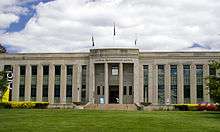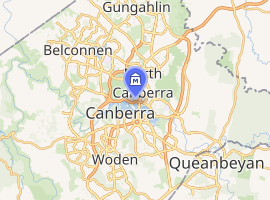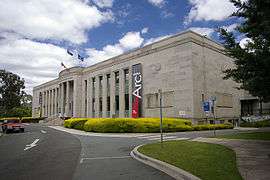National Film and Sound Archive
The National Film and Sound Archive of Australia (NFSA), known as ScreenSound Australia from 1999 to 2004, is Australia's audiovisual archive, responsible for developing, preserving, maintaining, promoting and providing access to a national collection of film, television, sound, radio, video games, new media, and related documents and artefacts. The collection ranges from works created in the late nineteenth century when the recorded sound and film industries were in their infancy, to those made in the present day.
 | |
 | |

| |
| Established | 5 April 1984 |
|---|---|
| Location | McCoy Circuit, Acton, Australian Capital Territory, Australia |
| Coordinates | 35.283950°S 149.121075°E |
| Type | Audiovisual Archive |
| Collection size | 3 million works |
| CEO | Jan Müller |
| Chairperson | Gabrielle Trainor AO |
| Owner | Government of Australia |
| Employees | 162 (at June 2019)[1] |
| Nearest parking | Free parking surrounding the building on Liversidge Street |
| Website | www |
The NFSA collection first started as the National Historical Film and Speaking Record Library (within the then Commonwealth National Library) in 1935, becoming an independent cultural organisation in 1984. On 3 October, Prime Minister Bob Hawke officially opened the NFSA's headquarters in Canberra.
History of the organisation
The work of the Archive can be officially dated to the establishment of the National Historical Film and Speaking Record Library (part of the then Commonwealth National Library, precursor to the National Library of Australia) by a Cabinet decision on 11 December 1935.
After being part of the National Library of Australia (NLA) and its predecessors for nearly 50 years, the National Film and Sound Archive was created as a separate Commonwealth collecting institution through an announcement in Parliament on 5 April 1984 that took immediate effect.[2] At that time, an Advisory Committee was established to guide the institution.
On 21 June 1999, the name was changed to ScreenSound Australia, the National Collection of Screen and Sound, and changed again in early 2000 to ScreenSound Australia, National Screen and Sound Archive. It reverted to its original name, National Film and Sound Archive, in December 2004.
In 2000, Screensound joined the PANDORA Archive, the web archiving project started by the NLA in 1996, as a collaborating partner.[3]
Meanwhile, consequent on amendments to the Australian Film Commission Act which took effect on 1 July 2003, it ceased to be a semi-autonomous entity within the Department of Communications, Information Technology and the Arts and became an integrated branch, later a division, of the Australian Film Commission, a funding and promotional body.
In 2007, the Liberal Government announced the creation of a new agency to be called Screen Australia which would incorporate the main functions of the Film Finance Corporation, the Australian Film Commission (including the Archive), and Film Australia. Following elections in November 2007, however, the new Labor Government implemented an election promise to allow the NFSA to become a statutory authority, similar to other major cultural institutions including the National Library of Australia, the National Gallery of Australia and the National Museum of Australia. The NFSA Act became law on 20 March 2008 and came into effect on 1 July 2008, with celebrations held that day.[4]
Inaugural Board
The Archive's first Board as a statutory authority comprised:[5]
- Professor Chris Puplick AM (Chair)
- Associate Professor Deb Verhoeven (Deputy Chair)
- Professor Jill Matthews
- Ms Grace Koch
- Ms Catherine Robinson
- Mr Andrew Pike OAM
- Mr Philip Mortlock
Board
- Ms Gabrielle Trainor AO (Chair)
- Mr Wayne Denning (Deputy Chair)
- Ms Toni Cody
- Mr Peter Rose
- Ms Fiona Scott
- Mr Kim Ledger
- Ms Caroline Elliot
- Ms Jude Donnelly
- Mr Ewen Jones
History of the building

The building to which the Archive moved in 1984 was the home of the Australian Institute of Anatomy from 1931-84. Originally it held the anatomy collection of Sir Colin MacKenzie.
The building is often classified as art deco, though its overall architectural style is technically "Late 20th Century Stripped Classical", the style of ancient Greece and Rome but simplified and modernised. It features a symmetrical façade, a horizontal skyline, classical columns and a central entrance. The decorative foyer features images of native flora, fauna and Aboriginal art and motifs. Face masks of well-known scientists from the late 19th century and early 20th century are featured on the foyer’s walls as a reminder of its previous incarnation as the Institute of Anatomy.
The building also features a landscaped courtyard, theatre and research centre. In 1999, the building was extended to accommodate the Archive's growth. The new wing’s design is in keeping with the Art Deco style of the main structure with details and finishes to match the original.
Collections
The NFSA collection includes more than 3 million items, encompassing sound recordings, radio, television, film, video games and new media. In addition to discs, films, videos, audio tapes, phonograph cylinders and wire recordings, the collection includes supporting documents and artefacts, such as personal papers and organisational records, photographs, posters, lobby cards, publicity, scripts, costumes, props, memorabilia, and sound, video and film equipment.
Notable holdings include:
- The Cinesound Movietone Australian Newsreel Collection, 1929–1975, a comprehensive collection of 4,000 newsreel films and documentaries representing news stories covering all major events in Australian history, sport and entertainment from 1929 to 1975. Inscribed on the Australian Memory of the World Register in 2003.
- The Story of the Kelly Gang (1906), directed by Charles Tait, is the first full-length narrative feature film produced anywhere in the world, and was inscribed onto the International Memory of the World Register in 2007.[6]
- The earliest surviving Australian sound recording, "The Hen Convention", a novelty song by vocalist John James Villiers, with piano accompaniment, recorded by Thomas Rome in 1896, on Sounds of Australia.[7]
- The earliest surviving film shot in Australia, Patineur Grotesque, footage of a man performing on rollerskates for a crowd in Prince Alfred Park, Sydney in 1896, shot by Marius Sestier.[8]
- original costumes from Australian films such as The Adventures of Priscilla, Queen of the Desert, Muriel's Wedding, Picnic at Hanging Rock, and My Brilliant Career.
A 2010 study compared the curatorial practices of accessioning and cataloging for NFSA collections and for YouTube with regard to access to older Australian television programs. It found the NFSA to be stronger in current affairs and older programs, and YouTube stronger in game shows, lifestyle programs, and "human interest" material (births, marriages, and deaths). YouTube cataloging was found to have fewer broken links than the NFSA collection, and YouTube metadata could be searched more intuitively. The NFSA was found to generally provide more useful reference information about production and broadcast dates.[9]
The NFSA announced plans to collect Australian-developed video games as part of its collection starting in 2019, with new titles to be added on an annual basis.[10]
Special Collections
- The Film Australia Collection contains a diverse range of more than 3,000 titles of Australian documentary and educational programs, spanning a century of Commonwealth documentary and docu-drama titles (1913–2008).
- Sounds of Australia (formerly the National Registry of Recorded Sound) is the NFSA's selection of sound recordings with cultural, historical and aesthetic significance and relevance, which inform or reflect life in Australia. It was established in 2007. Each year, the Australian public nominates new sounds to be added with final selections determined by a panel of industry experts.[11][12]
- NFSA Restores is the NFSA's program to digitise, restore and preserve, at the highest archival standards, classic and cult Australian films so they can be seen on the big screen in today's digital cinemas.
- The Oral History Collection houses oral history recordings.
- The Non-Theatrical Lending Collection includes non-theatrical screenings, which take place on a non-commercial basis and are held by educational, cultural, social and religious institutions; community groups; churches; film societies; government bodies; hospitals; libraries; museums and galleries.
- Australian Jazz Archive
Australian Screen Online
Australian Screen Online is an online database operated by the NFSA. It has both a promotional and educational function, providing free worldwide online access to information about Australian cinema and the television industry in Australia.[13]
Awards
Ken G Hall Film Preservation Award
The Ken G Hall Film Preservation Award was established in 1995 as a tribute to producer/director Ken G Hall. It is presented in recognition of an individual, group, or organisation, for their outstanding contribution to the art of moving image and its preservation. It is presented to candidates where there is a significant link between their work and its impact or relationship to the Australian film industry. Examples of this contribution include technical innovation, scholarship in the field, involvement with the survival of film as an art form and as a cultural experience, advocacy, sponsorship and fundraising.
- 2012 Susanne Chauvel Carlsson
- 2011 David Hannay
- 2010 Patricia Lovell
- 2009 Ian Dunlop
- 2006 Paul Cox
- 2005 Phillip Noyce
- 2004 Graham Shirley
- 2003 Tom Nurse
- 2002 Judy Adamson
- 2001 Murray Forrest
- 2000 Anthony Buckley
- 1999 Joan Long
- 1998 Not awarded
- 1997 Kodak Australasia
- 1996 Peter Weir
- 1995 Alan Rydge and Rupert Murdoch
National Folk Recording Award
The NFSA National Folk Recording Award was established in 2001 to encourage and reward excellence in Australian folk music recording. Award entrants are selected from recordings submitted each year to the National Folk Festival in Canberra. The judging panel comprises representatives from the National Folk Festival, ABC Radio and the Archive.[14]
- 2013 Not a Note Wasted by Luke R Davies and the Recycled String Band
- 2012 Carried in Mind by Jeff Lang
- 2011 Love and Sorrow by Kavisha Mazzella
- 2010 A Voice that was Still by Chloe and Jason Roweth, with Jim McWhinnie
- 2009 Urban Sea Shanties by Fred Smith and the Spooky Men's Chorale
- 2008 The Next Turn by Trouble in the Kitchen
- 2006 Diamond Wheel by Kate Fagan
- 2005 Songs of the Wallaby Track by Dave de Hugard
- 2003 Swapping Seasons by Kate Burke and Ruth Hazleton
- 2002 Bagarap Empires by Fred Smith[15]
- 2001 Follow the Sun by Seaman Dan
Cochrane-Smith Award for Sound Heritage
The Cochrane-Smith Award for Sound Heritage[16] recognises the achievements of a person who has made a substantial contribution to the preservation, survival and recognition of sound heritage. It is named for Fanny Cochrane Smith, who features on the only known recording of Tasmanian Aboriginal songs and language.
- 2012 Dr Ros Bandt
- 2011 Bill Armstrong
- 2010 Dr Karl Neuenfeldt
Orlando Short Film Award
The Orlando Short Film Award is an annual celebration of Australia’s best lesbian, gay, bisexual, transgender or intersex short films. It recognises the nation’s cultural diversity and the role screen culture plays within the broader community.
- 2012 Craig Boreham Writer and director of Drowning
- 2011 Grant Scicluna Writer and director of Neon Skin
Award for an Emerging Cinematographer
First presented in 2010, the NFSA Australian Cinematographers Society John Leake OAM Award for an Emerging Cinematographer is designed to enable emerging cinematographers to develop their craft, and is presented annually at the Australian Cinematographers Society Awards. The Award is named in honour of Australian Cinematographers Society (ACS) co-founder and industry icon John Leake OAM (1927–2009). The judging panel comprises the Federal President of the Australian Cinematographers Society, the Chief Executive Officer of the National Film and Sound Archive, and two other executive members of the ACS.
- 2013 Dale Bremner
- 2012 Jimmy Ennett
- 2011 Edward Goldner
- 2010 Kirsty Stark
Preservation Award
The South East Asia Pacific Audiovisual Archives Association (SEAPAVAA) NFSA Preservation Award recognises the extraordinary efforts of individuals or organisations within the South East Asia and Pacific region in preserving or promoting audiovisual archiving in the region. It is presented at the annual SEAPAVAA conference.
- 2012 Kae Ishihara
Exhibitions
The following exhibitions have been developed by the NFSA:
- The Art of Sound, in collaboration with regional art galleries
- Starstruck: Australian Movie Portraits, in partnership with the National Portrait Gallery of Australia. The exhibition premiered in Canberra from 10 November 2017 – 4 March 2018, followed by an Australian tour including Adelaide, Gold Coast, Bathurst and Geraldton.
From August 2018, the NFSA re-opened its exhibition gallery to present temporary exhibitions, including:
- Heath Ledger: A Life In Pictures, from 10 August 2018 to 10 February 2019. Developed by the Western Australian Museum.
- The Dressmaker Costume Exhibition, from 18 April to 18 August 2019. Developed by FilmArt Media and curated by designer Marion Boyce.
- Game Masters: The Exhibition, from 27 September 2019 to 9 March 2020. Developed by the Australian Centre for the Moving Image.
See also
References
- NFSA Annual report 2018-19 (Report).
- CA 4123: National Film and Sound Archive of Australia, Central Office, National Archives of Australia, retrieved 20 March 2014
- Webb, Colin (December 2000). "Because It Belongs to All of Us: National Arrangements for Digital Preservation in Australian Libraries, Australian Academic & Research Libraries". 31 (4): 154–172. doi:10.1080/00048623.2000.10755132. ISSN 1839-471X. Retrieved 2 May 2020.
Published online: 28 Oct 2013 [Routledge]
Cite journal requires|journal=(help) - Massola, James (2008) "Innovative film sets the scene for the Archive's new role", The Canberra Times, 2008-07-02, p. 7
- NFSA Board Archived 20 July 2008 at the Wayback Machine
- "The Story of the Kelly Gang (1906)". Memory of the World. United Nations Educational, Scientific and Cultural Organization. 2 October 2016. Retrieved 12 August 2020.
- "The Hen Convention"
- Patineur Grotesque
- McKee, Alan (2011). "YouTube versus the National Film and Sound Archive: Which Is the More Useful Resource for Historians of Australian Television?". Television & New Media. 12 (2): 154.
- Reilly, Luke (26 September 2019). "National Film and Sound Archive of Australia to Collect, Preserve Aussie Video Games". IGN. Retrieved 26 September 2019.
- "Sounds of Australia". Australian Screen Online. 11 November 1975. Retrieved 12 August 2020.
- "The complete Sounds of Australia list". National Film and Sound Archive. Retrieved 12 August 2020.
- "About ASO". Australian Screen. National Film and Sound Archive. Retrieved 12 August 2020.
- NFSA 2008 National Folk Recording Award Archived 2 March 2014 at the Wayback Machine
- Minion, Lynne (24 April 2009) "Uniting folk in triumph of voices", The Canberra Times, p. 5
- National Film and Sound Archive: Cochrane-Smith Award for Sound Heritage Archived 24 March 2012 at the Wayback Machine
External links
- National Film and Sound Archive
- australianscreen online
- "National Film and Sound Archive Bill 2008" (PDF). (91.5 KB) Accessed: 2008-04-22
- National Film and Sound Archive on Twitter

- National Film and Sound Archive on Facebook